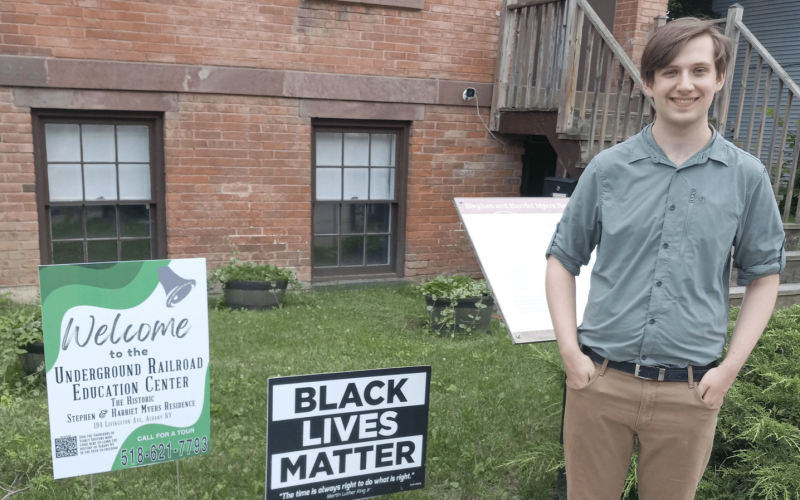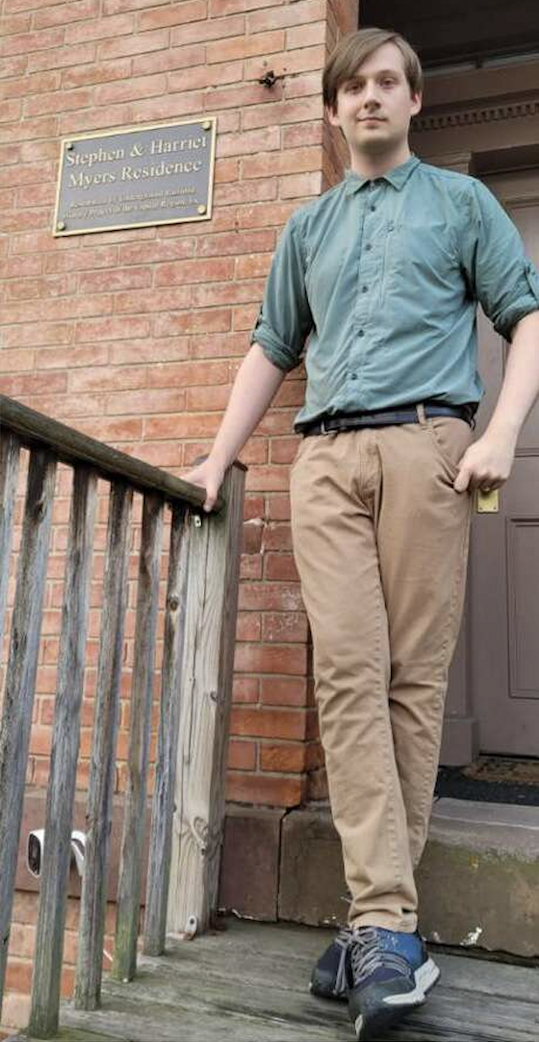UAlbany Summer: History Major Researches Local Underground Railroad Activity

By Bethany Bump
ALBANY, N.Y. (Sept. 12, 2023) — Maxam Daniels, a senior majoring in history at UAlbany, spent his summer researching freedom seekers who passed through Albany on the Underground Railroad.
He was offered the position by the Underground Railroad Education Center, a nonprofit in Albany that researches and preserves the local and national history of the Underground Railroad movement and its legacy to today’s social justice issues.
During his time at the center, Daniels was charged with studying the biographies of people who passed through Albany after escaping slavery in the South. Using research skills learned from his time in UAlbany’s history program, Daniels spent his days gathering information from online archives and primary sources, scouring old newspapers on microfilm at local libraries to fill in the gaps about known freedom seekers who passed through the Capital Region.
“We know there had to have been tens of thousands of people coming through (the Underground Railroad),” he said. “But because a lot of these people weren't ever taught literacy due to laws at the time, and also because newspapers generally weren't focused on disenfranchised groups in the 1800s, we just don't know that many names. What I'm doing is trying to illuminate more than just the names of the people, but who they were as a person.”
Albany was a stop for freedom seekers traveling north along the Underground Railroad from Washington, D.C., and Baltimore. Some would stay in the area, but others would continue west along the Erie Canal into Canada or continue to New England.
Civil disobedience and the incredible rescue of Charles Nalle
One famous freedom seeker who arrived in the area and decided to stay was Charles Nalle, who escaped slavery in Virginia and hoped to find freedom in the North and eventually reunite with his wife and child.
On his stop in Albany, Nalle met with famous local abolitionist Stephen Myers, who recommended he either stay put for the winter or continue west along the Erie Canal before the river froze over. Nalle decided to stay and in 1859 took up work as a teamster in Sand Lake before moving to Troy in 1860 to work as a coachman for wealthy industrialist Uri Gilbert.

At the time, the Fugitive Slave Act was a source of contention for communities in the North that were torn about whether to comply with returning former slaves to their enslavers. Vigilance Committees formed to aid freedom seekers in their escape attempts along the Underground Railroad, and provided active resistance when they learned freedom seekers had been captured from local communities, Daniels said.
That’s exactly what happened in Troy one day in 1860 when Nalle was attempting to visit the grocery store and was captured by a slave catcher hired by his former plantation owner.
“One detail I like giving, because it really shows the inherent evilness of what is going on, is that while he was being clasped in his chains, the slave catcher told Charles Nalle that these were the same chains that I clasped your youngest brother in when we decided to split your family up and sell half of them to a plantation in Alabama as a punishment for you running away,” Daniels shared.
When Nalle’s landlord realized his tenant was missing, he notified vigilance committees in Albany and Troy, which learned Nalle had been captured and was being held in a building at First and Congress streets in Troy. A crowd of protesters soon gathered around the building — including legendary abolitionist Harriet Tubman who was in town visiting cousins — and a standoff with police ensued.
After a friend of Nalle’s landlord secured a writ of habeas corpus from a state Supreme Court judge, authorities attempted to move Nalle to another location but as they did a riot broke loose. Tubman, along with community members, escaped with Nalle and took him by boat across the river to West Troy (modern day Watervliet). Once there, Nalle was captured again and taken to a site that today houses a McDonald’s.
Supporters and protestors — many of them women and African Americans — weren’t far behind. After commandeering ferries across the river, a crowd of some 2,000 people surrounded the building. When Tubman and a group of men rushed the building, police started firing and a riot once again broke out. Once inside, the protestors rushed and restrained police and were able to escape with Nalle to the Watervliet Arsenal and then eventually to Schenectady, where he stayed until citizens of Troy and Watervliet raised enough money to purchase his freedom.
On the same day as Nalle’s rescue, Rep. William Yancey delivered an infamous speech at the Democratic National Convention calling for the South to secede from the Union over the issue of slavery, Daniels said.
“And so his story was like a microcosm happening in the Capital Region that reflected the national level of debates at the time,” he said.
Nalle ended up staying in the Capital Region through the Civil War years and was eventually reunited with his family. In the 1870s, he moved to Washington, D.C., where he died.
Daniels picked up many of the skills he used to research Nalle’s story while enrolled in undergraduate and graduate-level research methods classes through UAlbany’s combined BA/MA program in history.
The Underground Railroad Education Center, which is working to expand into a full-fledged museum, plans to use Daniels’ research for exhibitions and tours in the future, he said.
“One thing that the Underground Railroad Education Center likes to stress is that the Underground Railroad is really best understood as one of the largest instances of civil disobedience in American history,” he said. “Charles Nalle’s story in Troy is a very direct example of spontaneous action that has very strong parallels to things like the later Civil Rights movement and George Floyd protests. It's one of the early instances of mass scale civil disobedience happening right here in the Capital Region, and many people just don’t know about it.”




